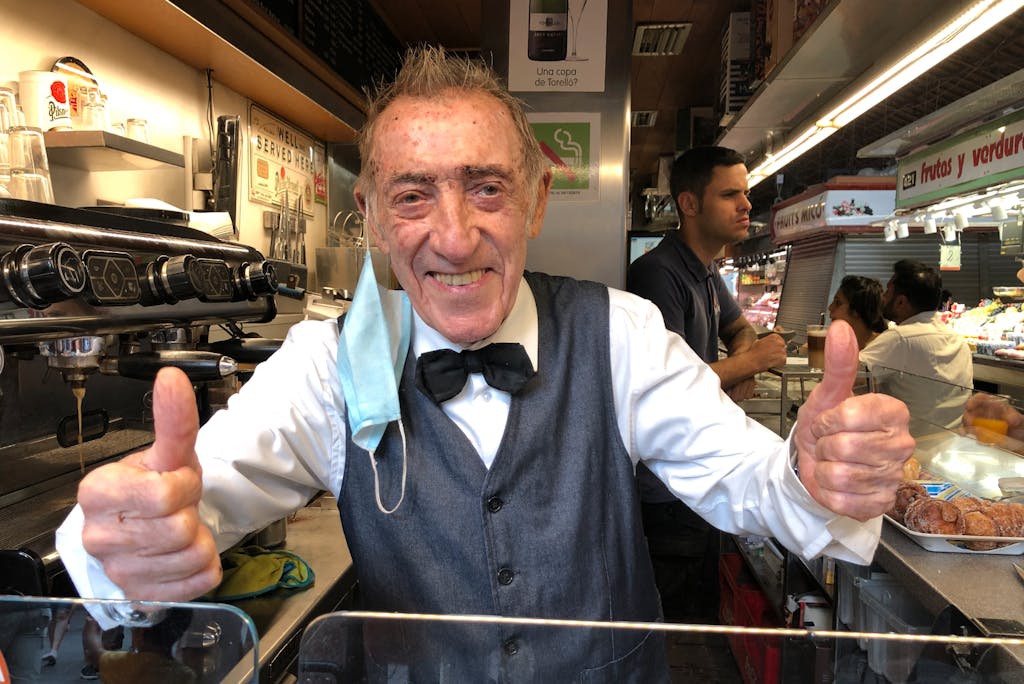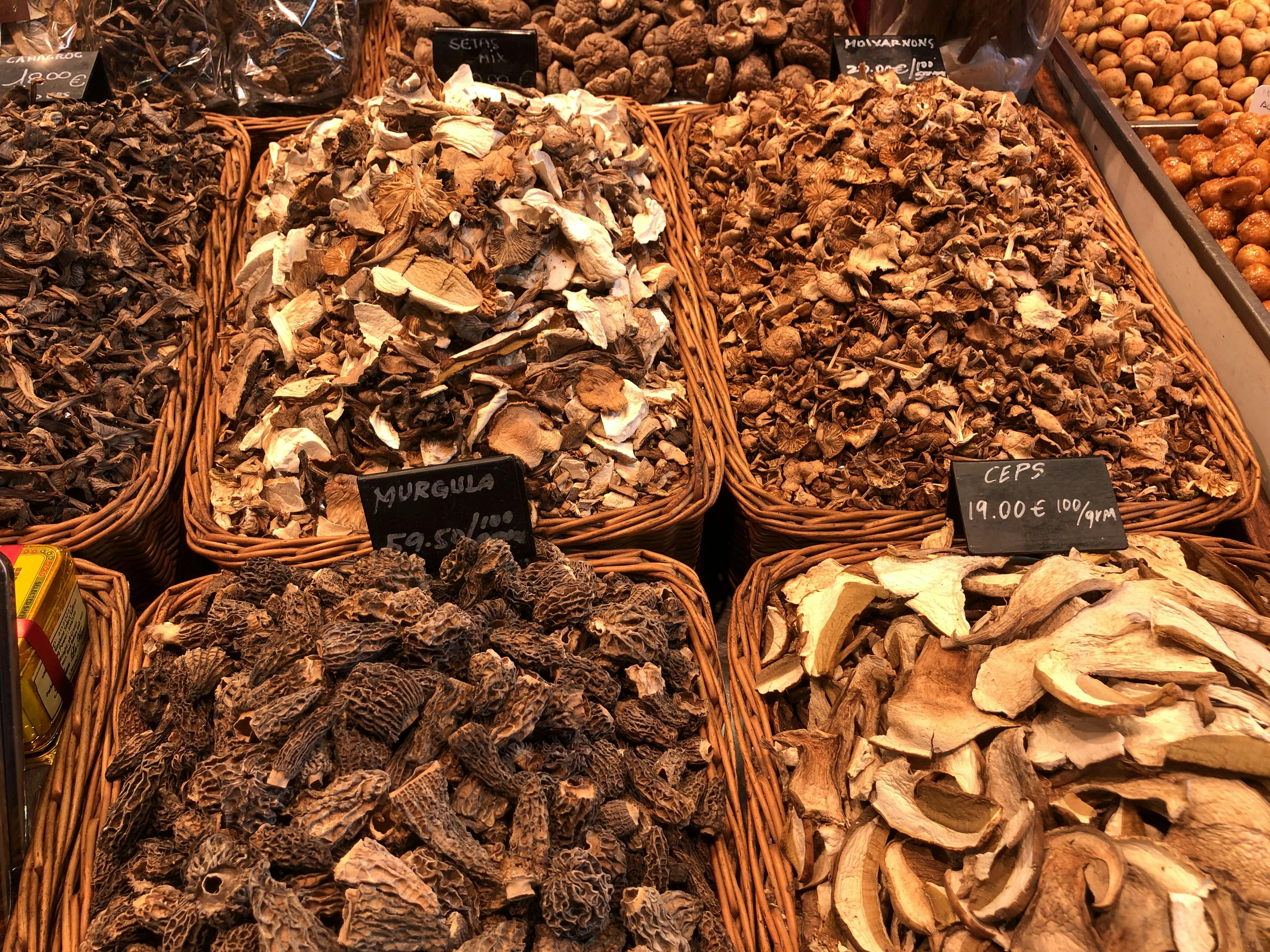Things to Do in Barcelona: A Foray through Spain’s Most Iconic Market
When it’s sweater season in Barcelona, it means there’s one thing on everybody’s mind: mushrooms. Come autumn in Catalonia, a fungi-based buzz descends on the city: Neighbors compare recipes, foraging tips are overheard on the metro, restaurateurs claim the meatiest chanterelles. It’s one of the top things to do in Barcelona in fall.
Of all the endearing quirks of the Catalan character, perhaps this is the winner: a steadfast love and downright devotion — to mushrooms.
The obsession spans city to countryside and transcends age, gender and socioeconomic class. A pop-up on my computer from RENFE, Spain’s national rail service, offered not only a limited-time discount to famed fungi destinations but also a list of best practices on detecting, picking and preparing them.
“After a trip rich in flavor,” the promotion concluded, “the best way to travel back home is on a RENFE high-speed train, comfortably seated in an armchair, relaxing and admiring the beautiful autumnal landscapes parading before one’s eyes.” Everyone’s in on it.
For those of us not born in Catalonia or who don’t hail from mycological-minded lineages, there’s no better place to experience the fanfare than La Boquería, the largest food market in Spain — and Barcelona‘s gastronomic holy of holies. And there’s no better vendor to initiate one’s education than a small, family-run stall in the far back corner called Bolets Petràs.
A market like no other
La Boquería houses hundreds of purveyors selling everything from arroz to zamburiñas, six days a week, year round, to this food-crazed city. I love strolling its aisles in the early morning when locals and Michelin-star chefs alike arrive for first picks. At 28,000 square feet, the market and its color, scent and immaculately presented goods are symphonic in scale, containing the entirety of Spain’s culinary history — a seasonal master class unlike any other in the city. You just need to know whom to go with, as there are various Barcelona tours that visit the market.
I’ve accompanied my friend Xavi Morón, chef, food designer extraordinaire and unabashed lover of bolets (mushrooms in Catalan). I met Xavi years back when I was invited to his enormous open kitchen (and former atelier of contemporary Catalan artist Antoni Tàpies) that doubles as gallery space and photo studio. I had just entered when Xavi was in the throes of a Eureka moment, having recently perfected his latest creation: a floating cloud of coffee.

We have collaborated many times since, and I’ve had the pleasure of attending several of his avant-garde culinary forays, including an entire mushroom-based dinner. (Xavi leads Silversea’s S.A.L.T. Experience in Barcelona, titled “The History of Barcelona in 7 Courses”; it’s a multisensory meal that starts in La Boquería and continues in his kitchen, each dish reflecting a historical period of Barcelona, from Greco-Roman and Judeo-Moorish to Renaissance and Modern-Contemporary, and each course coupled with period music.)
We approach Bolets Petràs, and I’m warmly greeted by Xavier Petràs, third generation in a family business started by his grandfather Antoni in the 1960s. I find an overwhelming array of mushrooms of all shapes, sizes and textures, bearing such names as rossinyol petit, rovelló gros, camagrocs, llanega, trompeta de la mort, greixa d’avet, murgula, cardo, ceps, fredolic and my favorite ou de reig — the king’s balls.
“We don’t pick mushrooms,” Xavier is quick to note. “We hunt them.”
Indeed, the Catalan term caçar bolets means “mushroom hunting,” a subtle but telling distinction suggesting a more calculated air to the endeavor.
Catalans classify bolets, the general word for these earthy treats, into 26 groups — a national sport indeed. We squeeze, smell and deliberate the day’s menu and fill our sacks.
A sensory delight, over and over again

La Boquería is home to nearly 350 stalls, each a universe unto itself, full of magical expertise and deep lines of family history. Visiting is one of the top things to do in Barcelona, especially for culinary travelers. The eye delights in dizzying displays of fresh fruits and vegetables, plump figs and green olives, mountains of spices, colorful tins of paprika and sardines, salt cod, cheese wheels, tongues and livers, marbled tomahawk cuts and heavenly thin slices of nutty jamón.
From the high-altitude pastures of the Pyrenees to the rice fields of l’Empordà and the abundance of the Mediterranean, a walk through these aisles is a celebration of regional flavor, a cacophony of the day’s catch. This is a living history lesson on the Catalan spirit and its irresistible culinary tradition.
The history of La Boquería dates to the 13th century when tables were set up outside the old city gate to sell meat, among them boc, the ancient Catalan word for “goat” from which today’s name is derived.
It wasn’t until 1840 that the market was legally recognized and a physical building erected. The official inauguration took place March 19 of that year — St. Joseph’s Day, which Catalan households celebrate by preparing St. Joseph’s cream, also known as crema catalana or, on the opposite side of the Pyrenees, crème brûlée.
Those with a discerning eye will notice the semi-translucent golden spheres of sugar in the form of glass tiles above the market’s entrance, not the only reference in this city where cuisine informs architecture (Josep Puig i Cadafalch’s beloved Modernist masterpiece Casa Amatller on Passeig de Gràcia — commissioned by wealthy chocolatier Antoni Amatller in 1898 — looks like a giant gingerbread house).
The characters of the place

But food is not the only highlight of La Boquería. Eccentric personalities abound, including Juanito from Bar Pinotxo, who, donning a bow tie, continues making café con leche well into his 80s. Beyond coffee, this family-run stall’s specialty is esmorzar de forquilla (breakfast with a fork), a hearty, stew-based dish traditionally eaten by workers. Think garbanzos, braised meats and morcilla (blood sausage). Shoulder-to-shoulder, patrons and tourists alike sit at Pinotxo’s counter, paper placemats and all, and take it all in.
Xavi and I go to another favorite, El Quim de la Boquería, an ebullient market restaurant with a staggering selection of tapas, croquettes, anchovies, fried artichoke hearts, macerated olives, slow-roasted vegetables, oysters, calamari, fresh fish, sandwiches and stews, all made to order. I go for their specialty — a scrambled egg tortilla with assorted mushrooms in a cava reduction. It’s not yet 9 a.m. I look at my paper placemat, which reads, “If unicorns existed, this is where you’d come to buy them.”
I couldn’t agree more.
